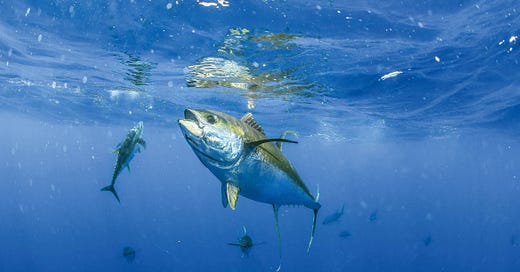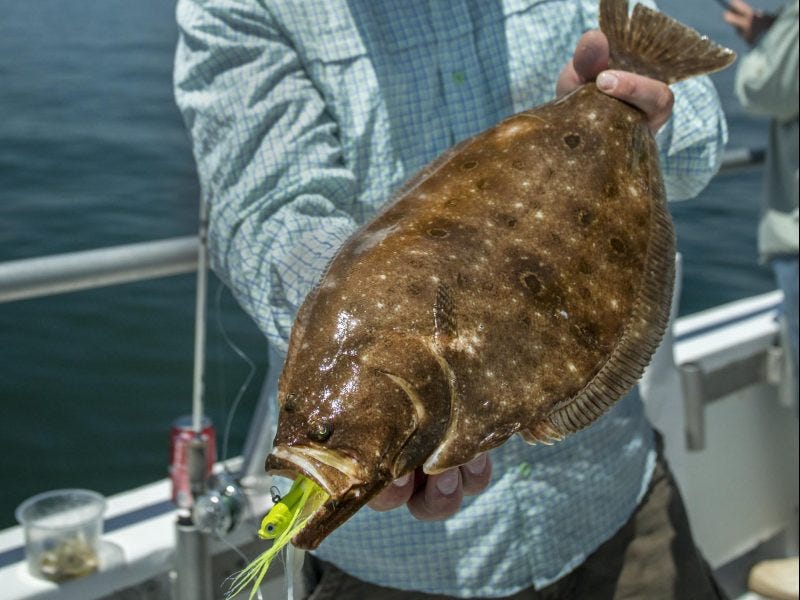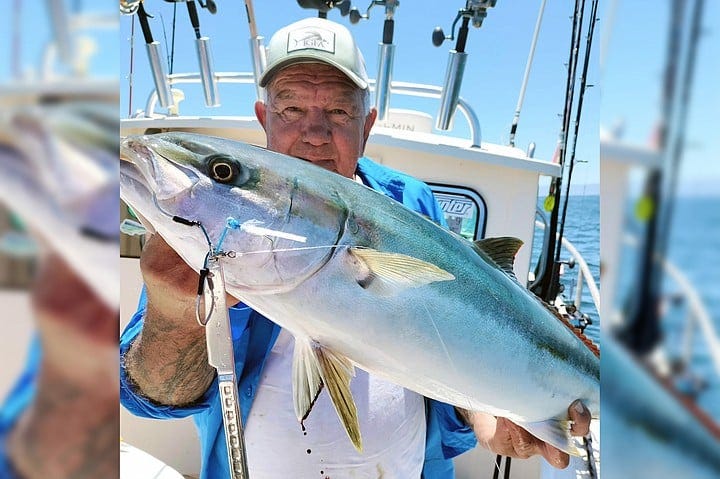The maritime law of salvage has its origins in Roman law, which dictated that one who preserved or improved upon the misplaced property of another was owed compensation, even if the service was not requested. Let’s get out the inter-webs seiner and get to work…
Podcast of the Week: Training a Boat Dog (CaptainsCollective) —> Bob Owens of Lone Duck Dog Chronicles discusses tips and training tactics for all things boat dogs. Listen along with your good boy to get them salt-ready.
Video of the Week: The RonZ Double (or Triple) Rig for Tuna w/ @bhagz_fishing —> A fresh and customizable twist on a classic technique, applicable for early and mid-season season BFT keyed on sandeels. Since it can be utilized on both spin and heavy conventional tackle, you can make this tactic as finesse-y or beefy as you need depending on conditions. Based on which brand/weight of jig-head you use, I can see this being effective in most 80-250fow scenarios.
Reports: OnTheWater / Fisherman Mag / SaltyCape / HullTruth / StripersOnline
Cape Cod Tuna Watch: With a push of 60-70” fish seen out of Jersey, a few pockets of warm water seeping in South of the Vineyard and a monstrous eddy swirling away in the Veatch / Hydro area…tasty conditions seem to be coalescing. Wouldn’t be surprised by a few sightings Out East in the week(s) to come, if they aren’t there already…stoked, much?
Short Story - ‘Plata o Pollo’
Grasping the door handle and bracing for a blast of humidity, I shake off the remnants of a mezcal nightcap and plunge into the sweet-smelling darkness. The prior night’s revelry had been amongst old friends, bonding over blackjack at the Parrot Club, the type of establishment where laughter often comes perforated by tequila hiccups and the occasional fisticuffs. Alone now, the mechanical whine of slot-machines replaced by rising notes of Warblers and frond-rustling Iguanas, I’m wade in the shoes of a daydream no hangover can diminish.
The turquoise waters of Cruz Bay were not yet perceptible at this unholy but precisely-chosen hour as I leave the compound. It would be several more minutes before twilight’s first grayish rays would mount the verdant canopy overhead. Cornering the dust-covered square and heading for beachfront, I replay the story told by the shop-owner in Red Hook, the tip scored from a friend who’d passed through the port a few months back, and try to visualize how the falling tide might wash through the ferry-worn channels of the bay.
Sand crunching underfoot as I enter the shallows, I make for a cluster of mangroves, loosely organized like an outstretched palm dipping into the water. Making short back-hand pitches with the rod, my lure plies the crannies of the cover, hauling nothing but water. Edging around the grove boughs up to my waist in bath-water, the tide ebbs and flows, small baitfish venturing close to inspect the foreign intruder. Then, in a shower of scales, the water explodes twenty feet away at my two o’ clock, breaking the pre-dawn silence unceremoniously. After seeing it so many times on video, the all too tangible spray of Mullet was immediately recognizable, setting my neck hair on edge.
As my watch ticked towards 5am and the promise of a sunrise, the tide seemed to hold its breath for what would come next. Another side-arm pitch of the rod put my soft-plastic just beyond the shadowline of a weather-beaten catamaran on anchor. Moments pass, line slipping off the spool as the bait settles on bottom, a slight outgoing current pulsing against the semi-taught leader. I lift and drop, feeling the subtle tick-tick of the jig-head flitting through turtle grass and then the unmistakeable THUMP of a prehistoric jaw slamming shut on my line. A primal connection between man and Silver King, confirmed.
Before a sweeping hookset is even complete, the Tarpon is airborne, head thrown back and mouth agape, tail swept forward in a moment of fluid non-resistance. Rod loaded to the cork, I’m dragged further onto the flat, the Stradic 6K paying line in pelagic-like fashion. As the poon’s tail smashes back onto the water’s surface, the cove comes alive as if struck by biological thunderbolts. From the canopy above comes the angry trills of Pelicans and Egrets, while the surface dimples with more unsettled Mullet and juvenile Crevalle.
Unbeknownst to me, my focus being the line cutting the water’s surface towards a long-abandoned mooring ball, I’m at risk of being flanked. A horde of feral chickens, seemingly determined to foil my angling efforts after such a rude awakening, cluck and strut along the shoreline, bristling for trial by combat. Their sudden appearance, and the absurdity of the pelagic and poultry pincer movement add a touch of whimsicality to the scene, even though it was not fully appreciated in the moment.
With each jump and drag-ripping dash, I feel the Tarpon's power waning as the rod butt digs deep into my hip, a fiendish smile creeping across my face. Slowly, but surely, the fish circles into the shallow grass-bed and its forward momentum is fortuitously arrested. As the taste of salt and victory percolate, pulse still pounding in my ears, I make a desperate reach and just manage to secure the lower-lip as the jig, bent hook-point and all, tumbles out of the hinge of the armor-plated jawline. Mutual respect was observed, perhaps, as we both share a moment of recuperation and a wide-eyed stare at the receding starlight and marching orange glow on the horizon.
Five Ways to Rig Live Baits for Better Hookups (SaltwaterSportsman) - “Anglers fish in so many different conditions: prime ocean with features for specific pelagics; bottom structure where currents influence where fish will stage; inshore docks and bridges. All this variability means you have to treat rigging live baits for inshore, coastal and offshore gamefish like a science. If you can isolate the behavior your target wants to strike, you can use hook placement to make your bait behave in that fashion.” —> 1) Dorsal Rig - For baits intended for slow-trolling, drifting and kite-fishing, primarily goggle-eyes, runners and mullet, place a hook in front of their dorsal fin. Especially important for kite-deployed baits, the down-turned head and swimming motion of a dorsal-hooked bait will keep water flowing across its gills, even as its back and tail splash in the waves at the surface. 2) Nostril Rig - You should also use bridles when pinning the nostrils of midsize baits like horse pilchards, large herring and menhaden. Nostril-pinned baits swim near the surface with a drifting boat and into the current at anchor. 3) Anal Fin Rig - If you want your bait to swim away and even downward from your boat, place a hook in front of its anal fin. Cast it out and, while free-lining, periodically tug on the line. Doing so interrupts the bait’s forward momentum and slows the oxygenated water flowing across its gills, causing it to panic.
The Fluke Fishing Playbook (OTW #1 & OTW #2) - “Fluke hanging out at the reefs, wrecks, and other ocean structures focus on larger forage like sand lances, squid, juvenile sea bass, and crabs. Large curly-tails, like the Berkley Gulp 6-inch Grubs, tipped on 3- to 6-ounce SPRO Prime bucktails or Tsunami ball-head jigs become 7- to 9-inch baits, and doormat fluke love them. This is a great rig for anglers who prefer to actively jig for fluke. Work a bucktail structure jig vertically by bouncing it on a tight line to keep it from snagging between rocks or along wreck edges. It is ideal for fishing rough bottoms. The bucktail should be heavy enough to bounce on the bottom, which may be as light as 5/8-ounces in shallow water with light current, or up to 6+ ounces in deep water and strong current.”
The Story of the Cubavich - AKA The 1958 Rybovich 37', (BoatTrader) —> One of 13 originally made by Neptune Boat Works, these dayboats are regarded as a well kept secret. The story behind the build is that Hemingway developed a friendship with two young brothers, Pepin and Luis Aizcorbe, at the Hunting Club. Eventually the two brothers became top anglers, and with Hemingway’s approval, became founders of the Hemingway Fishing Tournament. It would come attract fisherman like Johnny Rybovich, who would organize a fleet of a dozen boats to make the annual pilgrimage to Havana. It also attracted Howard Anderson, an American who owned a chain of Texaco stations in Havana. One of his gas stations was located across the street from the brothers boathouse. Mr. Anderson would observe the building of the boats there, and one night had an idea for a new powerboat.
Andersons plan was as simple as it was underhanded: during the Hemingway tournament, him and the brothers would haul a Rybovich and copy the lines inch for inch, nail for nail. On the night of the foray they had a partner take the skipper of one of the boats to Tropicana Night Club and feed him rum. Meanwhile the boat was hauled and its lines were transferred to plywood forms. Then the Rybovich was returned to its slip, no one the wiser.
In September 1958, John Rybovich went to Havana for some fall Marlin Fishing and his friend took him to the Anderson boathouse. When the doors opened, there sat what appeared to be one of his hulls half-finished. Angry and disappointed by the betrayal, they had a falling out.
From the standpoint of trying to achieve an objective however, the boat was a huge success. Orders poured in from Americans, however for the Anderson and the brothers, this was only a hobby. They founded Neptune Boat Company with the intention of building 3 boats a year for friends, often refusing the $10,000 deposits checks. Over four years, Neptune Boat Company built 13 classic sport fisherman in 34'- 42'. The brothers insist that only the first one is a direct copy, later models adopting a bit more beam and a deeper V hull. Still, even veteran boatman can rarely tell them apart.
Amazingly, John Rybovich, Anderson and the Aizcorbes mended their relationship and Rybovich furnished Neptune with equipment, and through a third party, technical and mechanical know-how, and Rybovich yards have handled at one time or another all 13 builds.
Run out of Tuna Jigs? Try Some Silverware (SanDiegoReader) - “When so many big fish take you into the rocks, your supply of jigs can dwindle fast, and that’s what happened to Captain Cook this past month. He dropped me a message that if I was heading that way to bring any heavy jigs I had. Well, I hadn’t planned on it, and before I could’ve even got them to him, he found a remedy: Tableware. Butter knives. Just a hole drilled through the tip of the blade of a heavy butter knife and a pair of assist hooks on a ring added, and voila! A true knife jig. This has been done before, and some say the butter knife was the original butterfly/knife jig in the first place.“
Thanks for reading The Weekly Salvage, until next week!
Have feedback or want to learn more?
Reach out to us on IG @Blowin_We_Goin








